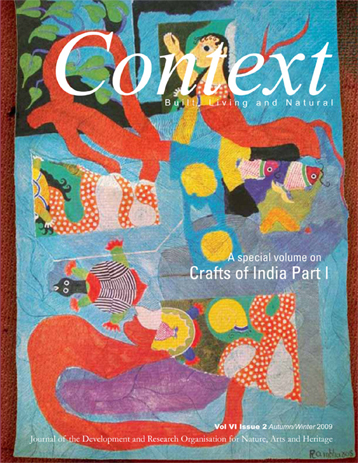Special Issue on Crafts of India Part 1: Volume VI Issue 2
About the Volume
Though the crafts of India are an integral part of the country’s cultural heritage and identity, we have yet to identify its economic potential as a national industry and as a tool for development. The recent government initiative of setting up a National Mission for the cultural and creative industries is a much needed and long-delayed step in this direction. However, much work remains to be done whether it be in undertaking a mapping exercise to understand the extent of this sector and the issues that it is ridden with, conserving cultural skills and knowledge, creating sustainable employment for crafts persons and artisans, disseminating craft skills or providing financial and legal support for this highly skilled but vulnerable section of society.
As part of our commitment to the revival of crafts, DRONAH presents two special volumes on ‘Crafts of India.’ The first volume contains a series of essays by various sectoral experts on a wide range of issues pertaining to the development and conservation of Indian crafts skills. Thus, the section titled ‘Crafting Futures’ discusses potential directions for policy development and the role of craft education and knowledge dissemination in creating an appropriate framework for development initiatives. ‘Access, Livelihood and Development’, showcases particular examples of successful design and market interventions in the crafts sector as well as highlights various issues that impede artisans’ access to sustainable income as well as working conditions. The ‘Redefining Craft’ section deals specifically with popular notions of what constitutes ‘craft’ and the manner in which such notions impact the economic value as well as aesthetic and intellectual appreciation of crafts objects and skills. Finally, the ‘Crafts and Environment’ section deals with the environmental impact of the crafts industry and contemporary experiments in environmentally sustainable models for the same.
The second volume specifically focuses on regional perspectives through the sections ‘Documenting Crafts’, ‘Crafts in Transition’, ‘Lessons from Creative Collaborations’ and ‘About Few Crafts’. It covers collaborations of crafts communities with designers, educationists and organisations with the aim of understanding the spectrum that is the Indian crafts sector in varied ways, as reflected in the experiences of organisations and institutions such as Dastkar, Dastkari Haat Samiti, Kala Raksha Vidhyalaya and Dakshinachitra
.The articles in these special volumes address some of the ironies and inconsistencies that plague the crafts sector of India. For instance, while ‘Dilli Haat’ is a benchmark initiative that acted as a catalyst for setting up similar regional and urban crafts centres across the country, traditional crafts clusters across the country (such as the Kumartuli settlement in West Bengal) which have become part of urban areas are now being included in the ‘slum improvement sector’ under the Jawaharlal Nehru National Urban Renewal Mission (JNNURM) scheme. It is apparent that all such urban developmental initiatives for the sector require a multi-disciplinary participation, with artisans, designers, entrepreneurs, NGOs, architects, urban planners and other stakeholders working together towards creating a practical framework and action plan. We hope these two volumes shall serve as a catalyst for just such a joining of forces!
Shikha Jain
Contents
A special volume on Crafts of India: Part I
About the Volume
Towards a Creative Society: Role of crafts in the future of education
M P Ranjan
Crafting Futures
Crafts Policy and Planning: The way forward for India
Ashoke Chatterjee
Indian Handicrafts: Directions for state intervention
M V Narayana Rao
Putting Ideas First: The use of knowledge as a catalyst for development, equity and growth
Ritu Sethi
Access, Livelihood and Development
Inclusive Marketing: Empowering the crafts sector
Jaya Jaitly
The crisis of Kumartuli: A crafts village in Bengal
Debashish Das
Tradition and Transition: A crafted solution to development
Laila Tyabji
Crafting Access: Indian crafts in a globalised world
Sharmila Wood
Redefining Craft
New Meanings for Craft
Arvind Lodaya
Rangolee: Traditional art form to teaching aid
Madhuri Bapat
Mithila Painting: Folk craft or contemporary art
David Szanton
Crafts and Environment
Common Ground: Changing land and water use by traditional textile artisans in Bagru
Alicia Ory DeNicola
The Balotra Experiment: Debating waste management technologies
Ramya Swayamprakash
Book Review
The Craftsman by Richard Sennett
Reviewed by Azhar Tyabji

